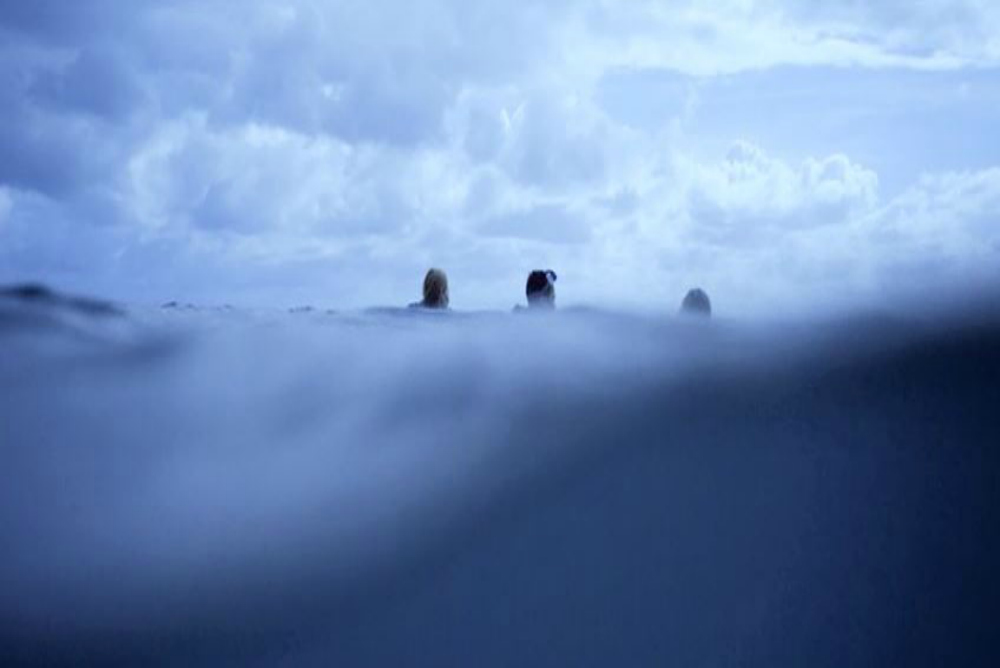Shark Week in July seems to have become a staple of our seasonal calendar, so now’s a good time to think about sharks in horror film. I’d like to propose two broad categories of shark horror. One falls under the rubric of what critic Michael Fuchs has aptly called “naturalistic horror,”[i] which puts us firmly in the terrain of the shark, in a world relatively indifferent to humans (except as food), in which the good guys don’t necessarily come out on top (or even alive), and death is random. (Check back later this week for the second kind!)
Perhaps the first moment of naturalistic shark horror on film occurs in the The Beast from 20,000 Fathoms (Eugene Lourie, 1953). One of the principal characters, paleontologist Thurgood Elson ventures down into the ocean in a diving bell. He witnesses the battle between a shark and an octopus—and while his primary interest is the re-awakened Rhedosaurus that’s heading toward New York, the extended intercut scenes of the shark and the octopus—pure nature, locked in the dance of predation—is a naturalistic moment that sits in uneasy tension with the sensationalistic spectacle of an extinct dinosaur wreaking havoc on Coney Island. True to the tenets of naturalistic horror, Professor Elson does not survive his dive. Before he leaves his familiar world for the mystifying depths of the ocean, he remarks: “I feel I’m leaving a world of untold tomorrows for a world of countless yesterdays,” and, indeed, the ocean is a force that thwarts human hope and futurity.
Two stand-out films in the canon of naturalistic shark horror are Open Water (Chris Kentis, 2003) and The Reef (Andrew Traucki, 2010)—both of them absolutely terrifying depictions of humans encountering sharks in what is unambiguously the shark’s world.
Both films are based loosely on true stories and both involve people being abandoned in shark-infested seas. In Open Water, Daniel (Daniel Kintner) and his partner Susan (Blanchard Ryan) get left behind on a crowded scuba-diving excursion. Even though, at first, they see boats around them, they don’t try to save themselves, naively sure the boat will return for them. It doesn’t. And as night comes, so do the sharks. Daniel and Susan spend most of the film floating in place, waiting. At times they express their love for each other; at other times they bicker and blame each other. What happens to them is not particularly surprising, but agonizing, nonetheless, in its inevitability. In the way of naturalistic horror, rescue comes too late—and Susan’s final moments are cross-cut with shots of the rescue being launched. Her surprising final choice only heightens the ironic pathos of the belated rescue attempt.
In The Reef, a yachting accident leaves five friends with a choice: stay on the upended boat or try to swim for land. Four choose to swim, heading out into the unrelenting ocean—and the film follows them and the shark that follows them. What happens to them is also not surprising. Like Susan in Open Water, the protagonist of The Reef makes a choice at the end of the film: it is a very different choice than Susan’s—arguably a more heroic and significant choice—but it has the same outcome. Indeed, both Open Water and The Reef are filled with a sense of the futility of human choice. The characters in The Reef, in particular, choose to take charge of their fate—to swim rather than wait, to act rather than not—and yet their actual ability to direct their own fate is nil. In the end, it doesn’t matter much if you swim or float, try to save yourself or wait.
In both films, humans’ place in the pitiless terrain of nature—in the world of the shark, is beautifully rendered.
Philosopher and environmentalist Val Plumwood (who had her own horrific encounter when she was mauled by a saltwater crocodile in Kakadu National Park in northern Australia) has written eloquently about what happens to humans when they are caught in “the eye of the crocodile.”[ii] One goes from the center of the universe to meat, from being the origin of meaning to absolute meaningless. Both Open Water and The Reef put their human characters in “the eye of the shark” (something Jaws also famously did). To be in the “eye of the shark”—the very definition of naturalistic horror—is to be rendered inconsequential in an harsh and predatory universe.
In 1897, Stephen Crane, a writer in the American naturalist tradition, published one of the best shipwreck stories ever written—and it also happens to be a wonderful early fictional example of shark horror. Like Open Water and The Reef, “The Open Boat” is based on a real event as it follows the four survivors of a shipwreck who try to make it shore in a small boat. The story embodies its sense of the indifference of the universe in a shark, which is not named at first, called only “the thing.” As Crane puts it: “There was a long, loud swishing astern of the boat, and a gleaming trail of phosphorescence, like blue flame, was furrowed on black waters. It might have been made by a monstrous knife.”
True to the tenets of naturalistic horror, not only does death strike, but (as in The Reef), it’s the character who seems most fit to survive, the most heroic, who falls. When we enter the world of the shark, when we’re in the eye of the shark, our moral laws, our guiding principles, do not hold.
I’ll give the last word to Stephen Crane:
A man said to the universe:
“Sir I exist!”
“However,” replied the universe
“The fact has not created in me
A sense of obligation.”
You can rent Open Water on Amazon:
As well as The Reef:
[i] Michael Fuchs, “‘They are a fact of life out here’: The Ecocritical Subtexts of Three Early-Twentieth-First Century Aussie Animal Horror Movies,” found at https://uni-graz.academia.edu/MichaelFuchs.
[ii] Val Plumwood, The Eye of the Crocodile (Canberra: Australian National University, 2010), 10.



















